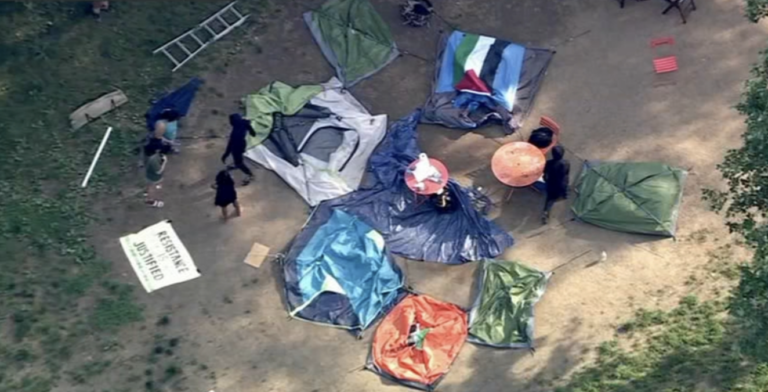Clark Park, situated at 43rd & Chester in University City, Philadelphia, has a rich history as a central community gathering space, hosting various events and gatherings over the years. The park has been a hub for activism and community engagement, from cultural festivals to social justice rallies. It is a symbolic location for the recent protests advocating for Palestinian rights. For instance, in the past, Clark Park has been a venue for environmental awareness campaigns, art installations promoting social change, and educational workshops on civil rights issues, showcasing its role as a platform for diverse community initiatives.
During the protests at Clark Park, the participants’ demographics were notably diverse, reflecting a wide range of ages, backgrounds, and ethnicities coming together to show solidarity with Palestinians. This inclusivity underscored the universal message of human rights and freedom that resonated with individuals from various walks of life. Moreover, the initiatives undertaken during the protests, such as donation drives for humanitarian aid and community outreach efforts to raise awareness about the Palestinian cause, highlighted the grassroots nature of the movement and its emphasis on tangible support for those in need. The unity displayed at Clark Park exemplified the power of collective action in addressing social justice issues and fostering a sense of belonging within the community.
Background of the Protests
The history of protests at Clark Park dates back to previous demonstrations centered around social justice causes and community activism. For example, in recent years, the park has been a gathering place for various movements advocating for racial equality, affordable housing, and environmental protection. These past events have set the stage for the recent protests, highlighting the park’s significance as a hub for civic engagement and grassroots activism in University City Philadelphia.

In addition to the legal hurdles faced by the protesters due to city ordinances banning camping in public parks, the encampment at Clark Park also conflicted with scheduled events, such as the Parks on Tap beer garden. This clash with planned activities raised concerns among city officials and park management, leading to the dismantling of the encampment early Thursday morning. The intersection of legal restrictions and logistical challenges underscores the complexities of organizing sustained protests in public spaces like Clark Park, where activism intersects with recreational and community events.
Details of the Protests at Clark Park
The participants in the protests at Clark Park represented a diverse demographic, including students, activists, and community members from various backgrounds. For instance, a college student, Sarah, shared how her Palestinian heritage motivated her to join the demonstration, emphasizing the importance of advocating for justice and freedom. This diversity of perspectives enriched the protests, showcasing a united front in solidarity with Palestinians facing adversity.
The initiatives undertaken during the protests went beyond symbolic gestures, with organizers actively engaging in donation drives, community outreach efforts, and educational workshops. For example, the organizers set up a donation center where community members could contribute food, clothing, and essential supplies for those in need, aligning with their commitment to community-based initiatives. These practical actions supported the local community and demonstrated the protesters’ dedication to addressing immediate needs while advocating for broader social change. The intersection of personal narratives, collective messages, and tangible initiatives at the protests underscored the multifaceted nature of the movement at Clark Park.
Response from University Leaders
The response from University leaders regarding the protests at Clark Park showcased a spectrum of reactions and strategies to address the situation. While some university officials engaged in dialogues with student groups to understand their demands better and find common ground, others took a more cautious approach, emphasizing the importance of upholding campus regulations and ensuring the safety of all individuals involved in the protests. For instance, at Drexel University, President John Fry condemned the disruptive protest and antisemitic behavior, urging for a peaceful resolution to the situation.
Moreover, university leaders grappled with the complex issue of divestment and institutional support for Palestinians, as these topics sparked debates within academic communities and among student bodies. The responses varied from outright rejection of the demands for divestment to more nuanced discussions about the role of universities in global conflicts and social justice movements. At the University of Pennsylvania, faculty members like Eve Troutt Powell and Dagmawi Woubshet participated in the protest, advocating for transparency in investments and showing solidarity with the Palestinian cause. This demonstrates the diverse approaches taken by university leaders in navigating the sensitive intersection of political activism and academic responsibility.
National and Campus-wide Impact of the Protests
The protests at Clark Park captured local media’s attention and garnered significant coverage on national platforms, shedding light on the Palestinian cause beyond University City Philadelphia. This widespread visibility highlighted the solidarity efforts with Palestinians and sparked conversations and debates on social justice, human rights, and international conflicts. For instance, the protests prompted discussions on the role of universities and their investments in shaping global issues and supporting marginalized communities.
The demonstrations at Clark Park were part of a larger tapestry of student activism sweeping campuses nationwide. The resonance of these protests echoed in similar movements and encampments at universities like Columbia, Harvard, and Yale, showcasing a collective student voice advocating for change. The engagement of students from various academic institutions in these pro-Palestinian demonstrations underscored a growing awareness and solidarity for global causes among the younger generation, reflecting a shift towards more socially conscious and politically active campuses. For example, the protests at Clark Park were not isolated events but integral components of a broader movement striving for social justice and equality.
Support and Opposition to the Protests
Community members from diverse backgrounds, including residents, students, and activists, expressed their perspectives on the ongoing protests at Clark Park. Many highlighted the importance of community-based movements in initiating social change and addressing pressing issues. For instance, a long-time resident of University City shared how these protests resonated with the historical significance of Clark Park as a space for community gatherings and activism, emphasizing the power of grassroots movements in advocating for justice and equality. Additionally, students from nearby universities supported the cause, citing the need for solidarity with Palestinians and raising awareness about their fight for freedom and self-determination.

Key organizers and spokespersons who spearheaded the protests were identified and profiled, offering insights into their diverse backgrounds and motivations for taking a leading role in the movement. For instance, one of the organizers, a Palestinian-American student, shared their connection to the cause and the impact of intergenerational trauma on their family, underscoring the emotional drive behind their activism. Another organizer, a community leader known for their previous involvement in social justice movements, discussed the significance of centering the protests on community-based initiatives and advocating for tangible support for the needy. These profiles provided a deeper understanding of the individuals driving the protests and the varied perspectives that contributed to the demonstration’s momentum.
Furthermore, the legal implications and challenges faced by the protesters in maintaining the encampment at Clark Park were detailed, shedding light on the complexities of navigating interactions with law enforcement and city officials. For example, protesters encountered issues related to city ordinances banning camping in public parks, prompting discussions on the boundaries of free speech and assembly within public spaces. Additionally, the efforts of legal advocates working pro bono to support the protesters in understanding their rights and responsibilities during the demonstration were highlighted, showcasing the intersection of legal frameworks and civil disobedience in the context of the protests.
I’ll be at multiple protests this weekend; stay tuned for updates! Be sure to visit Mecella for updates!



No responses yet